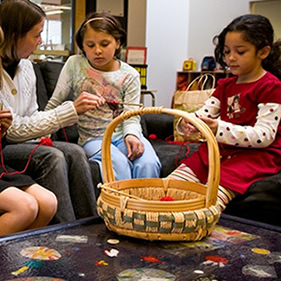


If you were to ask Montessori teachers which part of “curriculum” is the most important, my guess is most teachers would say Practical Life. Practical Life is the foundation for everything that follows in a Montessori classroom. It is also the one area of the classroom that does not require special materials and tools (other than adjustments for size). The materials used are easily found in your own home because the activities are the very same ones we partake in every day in our homes– things like sweeping, washing dishes, folding laundry, combing our hair, and getting dressed. Children already want to do these things when they see adults doing them– they want to be part of our world, and they want to feel grown up and important. We then simply alter the materials and environment so it suits their smaller size, and let them go to work!
The genius of the Practical Life exercises is two-fold:
- You are teaching the child how to care for himself and his environment, thus giving him independence (doesn’t have to rely on an adult to tie his shoelaces or comb his hair) and a sense of pride at being able to do these things all by himself.
- The exercises are practiced for the child’s fine and gross motor skills, allowing him to become better coordinated and learn how better to control and use his own body. This is an indirect preparation for later, more complex exercises and activities that require fine motor control and concentration.
As a stay-at-home mom, I am constantly looking for ways to incorporate Practical Life exercises into our home and routine. The great thing is, this isn’t all that hard… though it does require more time and patience, and I will likely have to go through and re-do things afterward anyway. This can be frustrating sometimes, but it can also be really fun and rewarding– there’s nothing like realizing your kid really can do a lot more than you’d given him credit for.
At 2 years of age, my son isn’t quite ready for any sort of formal lesson. But I try to involve him in different household tasks when I can. He loves to help unload the dishwasher (I put away the silverware first, but he does great with the plates, taking each out of the racks one by one and handing them to me to put away– we’ve only broken one bowl so far). He’s also a big fan of the vacuum cleaner and will want to “help” vacuum the carpet anytime we bring it out. One of his favorites is laundry– his “help” here can range from taking all the clean clothes from the basket and dumping them on my bed (and sometimes going back and forth a few times), but once or twice I even got him to happily put clothes and socks away in their proper drawers! We’re also working on learning how to get dressed and undressed. Just this week I was surprised to learn that he can take his jacket off all on his own!
He doesn’t always want to help, and sometimes he’ll abandon a job halfway through. And that’s OK – I don’t push it or force anything. When he does help, he usually seems very proud of himself for helping Mommy. I know it is helping him get a sense of his place in the household, and introducing the idea of everyone doing their part. And who knows, maybe this way he’ll just always know that it is part of his job as a member of our family to help out around the house, and battles over chores may not be as bad when he gets older (one can hope!).